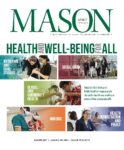
Datathon at the National Gallery of Art in Washington, D.C. Provided image
George Mason University art history graduate student Paul Albert and School of Business marketing faculty members Laurie Meamber and Gautham Vadakkepatt were among the teams of art historians and data scientists participating in the National Gallery of Art’s first-ever datathon, “Coding Our Collection.” The Mason team presented their findings in October 2019 before an audience at the National Gallery of Art (NGA) in Washington, D.C.
The NGA is the first American art museum to invite groups to analyze its permanent collection. The datathon coincides with other major efforts by the gallery to make its collection more available to the public. Using the gallery’s own data, teams looked at diversity in the materials on display at the gallery and in its acquisitions over time, among other topics.
The Mason team looked at the popularity of the artists in NGA’s collections. Using Wikipedia page views as a popularity measure, Albert says they assigned each of the artists featured an engagement score.
While the team wasn’t surprised to learn that NGA’s most popular artist was Leonardo da Vinci, “what surprised us was the second most popular artist was Neil Armstrong, the astronaut, whose moon photographs are among the NGA’s collection,” says Albert, who gave the presentation.
Albert said that, of the more than 10,000 artists presented at the NGA, the top 20 percent of artists accounted for 97 percent of the total Wikipedia page views. These are artists whose names most people would recognize—Pablo Picasso, Michelangelo, Andy Warhol, and Ansel Adams.
“The engagement scores we developed can help NGA’s outreach efforts to attract and educate the public,” says Albert.
What intrigued Albert about the project was the opportunity to examine the idea of “value” when it comes to art. “The field of art creates an idea of what is valuable, but what does the general public value?”
Albert, who led the Mason team, came to Mason after retiring from a career in the data sciences. He divides his time at Mason between classes in art history and computational social sciences. He consulted with the Roy Rosenzweig Center for History and New Media on this project and provides training on campus for Tableau data visualization software.
“Digital humanities offer a new and different way to understand things,” says Albert. “It broadens our understanding of our world and teaches critically important analytical skills.”

No Comments Yet »
Leave a comment